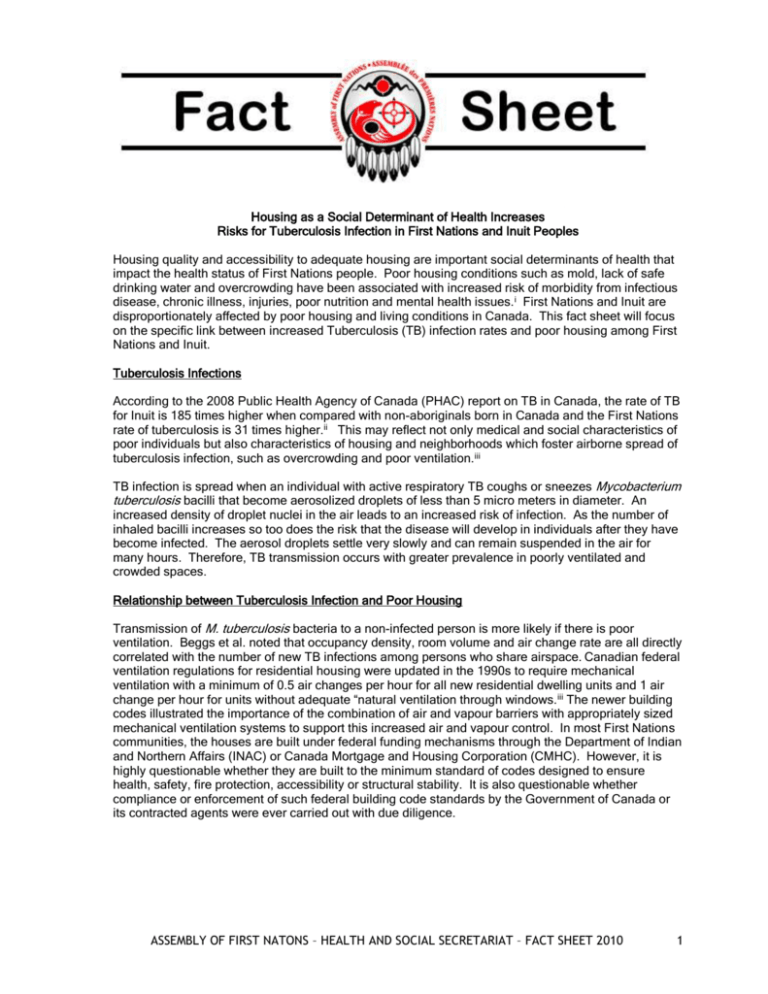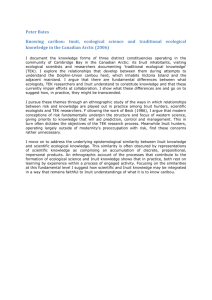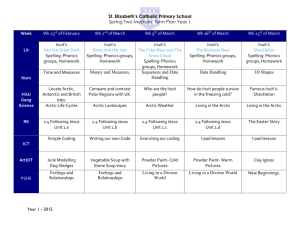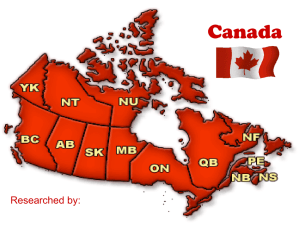Fact sheet
advertisement

Housing as a Social Determinant of Health Increases Risks for Tuberculosis Infection in First Nations and Inuit Peoples Housing quality and accessibility to adequate housing are important social determinants of health that impact the health status of First Nations people. Poor housing conditions such as mold, lack of safe drinking water and overcrowding have been associated with increased risk of morbidity from infectious disease, chronic illness, injuries, poor nutrition and mental health issues. i First Nations and Inuit are disproportionately affected by poor housing and living conditions in Canada. This fact sheet will focus on the specific link between increased Tuberculosis (TB) infection rates and poor housing among First Nations and Inuit. Tuberculosis Infections According to the 2008 Public Health Agency of Canada (PHAC) report on TB in Canada, the rate of TB for Inuit is 185 times higher when compared with non-aboriginals born in Canada and the First Nations rate of tuberculosis is 31 times higher.ii This may reflect not only medical and social characteristics of poor individuals but also characteristics of housing and neighborhoods which foster airborne spread of tuberculosis infection, such as overcrowding and poor ventilation.iii TB infection is spread when an individual with active respiratory TB coughs or sneezes Mycobacterium tuberculosis bacilli that become aerosolized droplets of less than 5 micro meters in diameter. An increased density of droplet nuclei in the air leads to an increased risk of infection. As the number of inhaled bacilli increases so too does the risk that the disease will develop in individuals after they have become infected. The aerosol droplets settle very slowly and can remain suspended in the air for many hours. Therefore, TB transmission occurs with greater prevalence in poorly ventilated and crowded spaces. Relationship between Tuberculosis Infection and Poor Housing Transmission of M. tuberculosis bacteria to a non-infected person is more likely if there is poor ventilation. Beggs et al. noted that occupancy density, room volume and air change rate are all directly correlated with the number of new TB infections among persons who share airspace. Canadian federal ventilation regulations for residential housing were updated in the 1990s to require mechanical ventilation with a minimum of 0.5 air changes per hour for all new residential dwelling units and 1 air change per hour for units without adequate “natural ventilation through windows. iii The newer building codes illustrated the importance of the combination of air and vapour barriers with appropriately sized mechanical ventilation systems to support this increased air and vapour control. In most First Nations communities, the houses are built under federal funding mechanisms through the Department of Indian and Northern Affairs (INAC) or Canada Mortgage and Housing Corporation (CMHC). However, it is highly questionable whether they are built to the minimum standard of codes designed to ensure health, safety, fire protection, accessibility or structural stability. It is also questionable whether compliance or enforcement of such federal building code standards by the Government of Canada or its contracted agents were ever carried out with due diligence. ASSEMBLY OF FIRST NATONS – HEALTH AND SOCIAL SECRETARIAT – FACT SHEET 2010 1 Numerous studies over the decades have catalogued the serious problems with housing and infrastructure for First Nations: shortages leading to severe overcrowding; lack of plumbing; no electricity; poor insulation; toxic mould; substandard construction; and an approximate 40% accumulation of units in need of repairiv Housing for First Nations and Inuit must be considered within the context of demographic pressures. First Nations and Inuit populations in Canada are young, increasingly urban, and growing at a rate nearly six times faster than that in non-Aboriginal populations. Statistics show that 26% of First Nations on reserve live in crowded homes, and for Inuit, 36% reported living in crowded dwellings. Almost half of Inuit in Nunavik, one of four Inuit regions, reported living in crowded dwellings. iii According to the CMHC, 50% of First Nations housing fell below CMHC standards for suitability and adequacy. This is further substantiated by the 2003 First Nations Regional Health Survey (RHS) which found that nearly one third of respondents (32.3%) considered their main water supply not to be safe for drinking and that about one in thirty First Nations households lack running water (hot and cold) or flush toilets. v In a 2002 Canadian study it was found that an increase of 0.1 persons per room (PPR) increased the risk of two or more cases of TB in a community by 40%.vi Statistics Canada uses the measure of PPR to assess crowding in houses.vii Environmental risk factors related to housing that may enhance the likelihood of TB transmission include the following: Exposure of susceptible individuals to an infectious person in a relatively small, enclosed space; Inadequate ventilation that results in either insufficient dilution or removal of infectious droplet nuclei; Recirculation of air containing infectious droplet nuclei; Duration of exposure and the susceptibility of the exposed person; and The risk of exposure is also increased if there is limited air movement in air enclosed space. Given the population growth of the First Nations and Inuit, these statistics are particularly worrisome. Housing on reserve and in Inuit communities tends to deteriorate more rapidly because of poor construction, lack of maintenance and overcrowding. These housing deficiencies can lead to elevated social, physical and medical stresses. Mould According to the RHS, almost half (44.4%) of all households reported having mould and mildew in the previous year.v Dampness and mould have not been directly linked with the acquisition of TB infection. However, they have been implicated in increased susceptibility to respiratory infection, asthma and allergies among Canadian children. Dales et al. found an association between exposure to indoor fungal contamination and altered T-cell differentiation in children.viii Children living in households contaminated with fungi had reduced CD4/CD8 ratios compared with children with less contaminated bedrooms. It has also been found that the presence of mould and fungi in homes is associated with suppressed T-cell production, which has been linked to slower recovery from TB. (2) ASSEMBLY OF FIRST NATONS – HEALTH AND SOCIAL SECRETARIAT – FACT SHEET 2010 2 Conclusion TB is a disease long known to be associated with poverty. In populations that already suffer high rates of TB, crowded housing and poor ventilation increase the risk of transmission and progression to disease among those who share living space. Numerous studies over the decades have catalogued the serious problems with housing and infrastructure for First Nations and Inuit and have shown that strategies to improve housing and health outcomes will require significant financial investments. In order to improve the current state of housing in First Nations and Inuit communities it is recommended that: i INAC and CMHC must make a concerted effort to work in collaboration with First Nations and Inuit to ensure compliance with national standards for housing; All houses being constructed should be built by professionals with demonstrated competency in housing and must meet the minimum requirements of the National Building Code Part 9 or a provincial, territorial or regional equivalent; and It must be clearly stated in Federal policies that the responsibility to meet the minimum standards of Part 9 of the National Building Code is the ‘Authority having Jurisdiction’. In many cases this is the First Nation that the house is being built in, or in other cases a Tribal Council or territorial Housing Authority that act on behalf of the First Nation. Centre for Housing Policy and Enterprise Community Partners (2007). The positive impact of affordable housing on health: A research summary. Washington, DC: Centre for Housing Policy and Enterprise ii Housing conditions that serve as risk factors for TB infection and disease - Canadian Tuberculosis Committee, 2007 iii Wanyeki, I et al (2006). Dwelling, crowding, and tuberculosis in Montreal. Social Science and Medicine 63:510-511. iv AFN First Nations Housing Draft Action Plan October 2005 v First Nations Regional Longitudinal Health Survey 2002-03 Report on First Nations Housing (2006) prepared by the First Nations at the National Aboriginal Health Organization vi Clarke, M et al (2002). The association of housing density, isolation, and tuberculosis in Canadian First Nations communities. International Journal of Epidemiology 31: 940-945 vii PPR is calculated by dividing the number of persons living in a dwelling by the number of rooms. A room is defined as an enclosed area within a dwelling that is finished and suitable for year round living the definition does not include bathrooms viii National Collaboration Center for Aboriginal Health (2009). Housing as a Social Determinant of First Nations, Inuit and Métis Health, British Columbia. ASSEMBLY OF FIRST NATONS – HEALTH AND SOCIAL SECRETARIAT – FACT SHEET 2010 3







